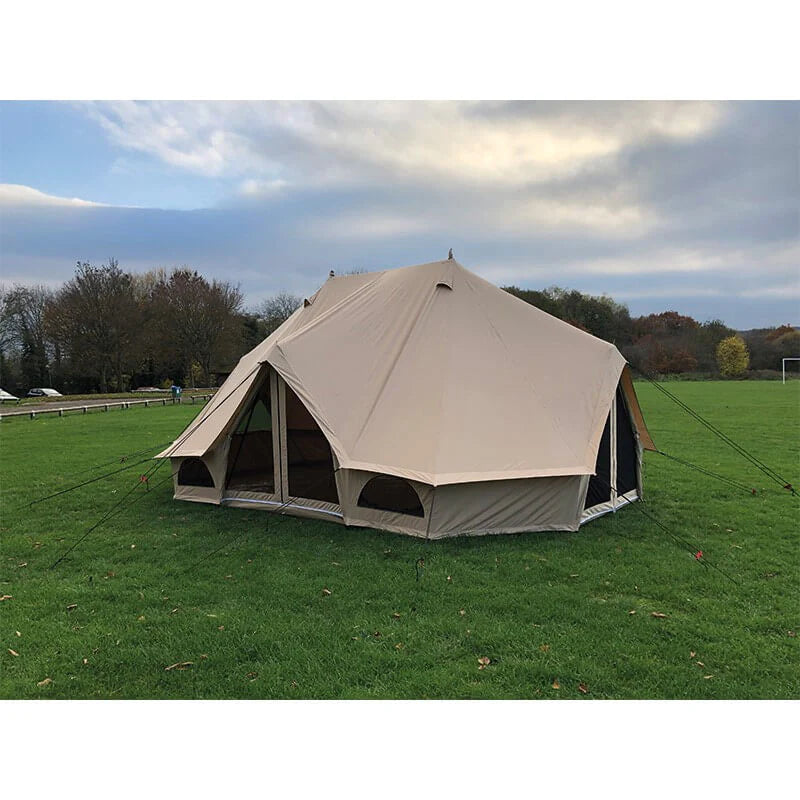Are Bell Tents Good in Wind?
Windy night, flapping canvas, your Glamping Tent doing the cha-cha—sound familiar?
Short answer: Yes, bell tents can handle wind—if you set them up right.
Their smart design helps, but it's all in the anchoring. Stick around for setup tips, model picks, and how to camp without chasing your tent!
Yes, Bell Tents Are Designed for Wind
Bell tents have become a favourite among outdoor lovers. They're spacious, stylish, and practical—but many wonder how they hold up in a storm. The good news? Bell tents can perform very well in windy conditions, provided they’re pitched correctly and made from quality materials.
Their classic shape isn’t just for show. It plays a big part in keeping the tent steady when the wind picks up.

The Aerodynamic Advantage of the Conical Shape
The tall, conical shape of a bell tent allows wind to flow over and around the structure.
This helps reduce the pressure on the walls and poles.
Unlike boxy tents that catch the wind, bell tents deflect it. This gives them a better chance at staying grounded when the breeze turns into a blow.
Their angled sides work with nature—not against it.
How Heavy Canvas Fabric Reduces Flapping and Adds Stability
Most bell tents are made with thick, durable canvas.
That heavy fabric isn’t just for keeping rain out—it also stays quieter and more stable in the wind.
Lighter tents often flap noisily or shake. In contrast, canvas helps muffle movement and keeps the interior calm.
It’s a key factor in wind resistance.
The Strength of the Central Pole and A-Frame Door
At the heart of a bell tent is the central pole.
This vertical support helps hold everything together and adds solid internal structure.
Some models also include an A-frame at the door, giving added strength to the entrance and distributing force more evenly.
These elements combine to make bell tents far more stable than they might appear.
How to Make Your Bell Tent an Unshakeable Fortress
The Golden Rules of Pitching in Windy Conditions
Even the best tent design won't save you if your pitch is poor.
A solid setup is just as important as the materials. Follow these golden rules to keep your bell tent rock steady.

Choosing Your Pitch: Using Natural Windbreaks
Always look for natural barriers like hedges, trees, or rocky outcrops.
They reduce wind exposure significantly.
Pitching behind a rise or in a sheltered valley can make a huge difference in performance.
Don't rely on your tent alone—let nature do some of the work.
Pegging for Power: Using the Right Stakes for the Ground
Your pegs need to match your terrain.
Soft ground? Use longer, heavy-duty stakes.
Hard, compact soil? Go for thick, solid pegs that won’t bend or pull out.
Cutting corners here is a surefire way to lose your tent.
Orienting Your Tent: Facing the Door Away from the Wind
Pitch your tent with the door facing away from the wind’s direction.
This simple adjustment prevents gusts from rushing in and unsettling the structure.
It also helps keep things calmer inside.
Facing into the wind may seem brave—but it's rarely smart.
Why a Low Profile is Your Best Defense
If high winds are forecasted, consider pitching your guy lines lower and tighter.
This creates a reduced profile that catches less air.
The lower the tension points, the harder it is for wind to lift or tilt the tent.
Think compact and grounded over lofty and loose.
Mastering Your Guy Ropes for Maximum Stability
Your guy ropes are the tent’s main defence against shifting and flapping.
Used properly, they act like shock absorbers and anchors combined.
Here’s how to get the most out of them.
The Correct Angle and Tension for Guy Ropes
Always peg your guy ropes at a 45-degree angle from the tent base.
This spreads the force more evenly and improves tension.
Too tight, and they may snap or shift the poles.
Too loose, and the structure wobbles.
Find the middle ground—and stick with it.
The "Double Pegging" Technique for Key Anchor Points
In particularly windy spots, consider doubling up your pegs.
Use two pegs at main stress points, placed in a V formation.
This improves grip and reduces the risk of a line pulling free.
It’s a favourite trick among veteran campers for good reason.
Daily Checks: Why You Must Re-Tension Your Ropes
Weather changes everything.
Rain, sun, and wind can loosen your lines throughout the day or night.
Take a few minutes daily to walk around your tent and re-tension any slack ropes.
It prevents small issues from turning into major ones.
A quick check beats a collapsed tent.

Advanced Tips and Final Checks for Stormy Weather
Extra Measures for Peace of Mind
If you’re camping through a storm, a few extra precautions go a long way.
These tips can help you stay safe and protect your setup when things get wild.
The Benefit of Adding Weight Inside Your Tent
Strategically placing heavy gear along the inside edge of your tent can help weigh it down.
This is especially useful in sudden gusts.
Keep your bags, water containers, or coolers close to the walls to add resistance from the inside out.
A little weight can make a big difference.
Using Storm Straps or Upgrading Your Guy Ropes
Some campers add storm straps over the canvas for an added layer of support.
You can also upgrade to premium guy ropes with better grip and stretch resistance.
These extras aren’t essential—but in serious wind, they’re worth having.
Better safe than sorry.
Knowing When to Take Your Tent Down to Prevent Damage
No tent is indestructible.
If a major storm is approaching, sometimes the best move is to pack up.
Taking your tent down early can prevent rips, broken poles, and other damage.
It’s not giving up—it’s protecting your investment.
Live to glamp another day.
Other content you might like:






Leave a comment